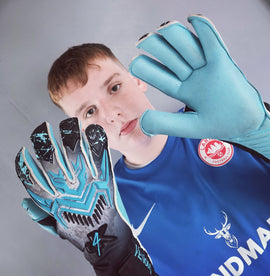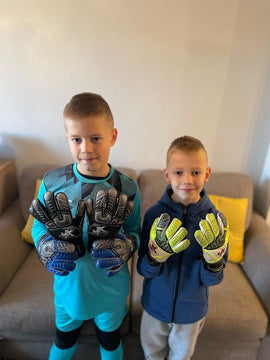In this goalkeeping training video and podcast, I'm going to be talking about one of the most common mistakes young and actually even older goalkeepers make and especially parents of goalkeepers make this mistake as well because they simply just do not know. Especially if you play or train on a local council field, you really need to listen to this video because I'm not saying all council fields are bad, but let's just say, well, I've seen my fair share of terrible council fields. So, again, if you play or train on a council field, please watch this video.
So, what I'm going to be talking about here is not only the importance of padded goalkeeping equipment, when you are doing your goalkeeper training but more importantly, wearing this goalkeeper gear at the right time of the season. There's a lot of goalkeepers now, and parents of goalkeepers, thankfully, have got the correct padded goalkeeping equipment, but they wear this gear the wrong time of the season.
Now, there's two types of goalkeeping equipment. There's the padded compression gear, which I'm not going to speak about in this video, but this the padded compression goalkeeping equipment, that's the material that is skin tight. It's like a base layer but with padding on the elbows for the goalkeeper. You can get them in shorts and three-quarter pants and in a jersey but they normally go under your goalkeeping kit. Now, me personally, I believe every goalkeeper should have padded compression goalkeeping equipment in their kitbag at all times for both playing and goalkeeper training, but I'll explain why in another video because in this video, I'm going to be talking about the foam padded goalkeeping equipment.
Now, if you don't know what the foam padded equipment is, this is the padded material on your goalkeeper jersey this is normally the foam padded material. You can also get the foam padded material in short, three-quarter pants, and long pants, and again, it's still an important part of the goalkeeping kit to have, and a lot of goalkeepers do have foam padded goalkeeping shorts, three-quarter pants, and or long pants, but they wear them at the wrong time of the season. Let me explain.
What a lot of goalkeepers do in the summer months when the ground is hard, they don't wear the padded gear because what happens is they go, "Wow, the sun's shining. I will wear me short sleeve T-shirt goalkeeper jersey for goalkeeper training or playing, put my shorts on because the sun is shining.
I can understand why a lot of goalkeepers do this because they obviously get hot and bothered wearing foam padded pants.
But it is a mistake not protected on a hard playing surface just because the sun's shining and especially when the pitch is dry. That's a recipe to get dead knees, dead hips, dead elbows which really hurt, by the way, and also lets not forget grass burns as well which are super, super painful!
Then what a lot of goalkeepers do and parents of goalkeepers, they wear the foam padded shorts, three-quarter pants, and or long pants in the wintertime when it's raining and the pitch is full of mud, and that's when you should not wear these foam padded goalkeeper training equipment.
You still should wear your padded compression shorts which I will explain in another video, but by wearing a three-quarter pants or a long foam pants while you play or train when it's raining or the playing surface is full of mud, what happens there is the foam absorbs the water and then the mud attaches to the garment, and you've probably seen this yourself.
If you are an older goalkeeper like me, you will probably laugh what I'm going to say next. You're probably going to go, "Right, I've been there. I remember that as well." But as a parent, you might see this yourself with your goalkeeping child. When they wear the pants, the long pants or the three-quarter pants and it's raining or the field is full of mud. What happens is the crotch of the pants is nearly by the floor, because the garment has absorbed that much moisture, and seriously, sometimes you could be carrying an extra one stone or two stone around in weight as a goalkeeper which is obviously not a good thing to do.
Having this dead weight also restricts your movement as a goalkeeper, and you're obviously basically playing with extra weight. So, you've got to be very, very careful, and think about this as well that when it's raining and when the pitch is soft and full of mud, you don't really need the foam padded equipment on that type of playing surface.
I still recommend that you wear the compression gear because, again, when you're playing on council fields, you don't know what's on that playing surface, even though that I am guessing your coaches and parents will most probably check the playing surface, you still just don't know what lies on these council fields. So, that's why I always recommend every goalkeeper has some type of protection when they goalkeeper train or play on a council field.
So, I hope that makes sense, guys. So, going back to what I was speaking about in this video, the foam padded goalkeeping shorts, three-quarter pants, and long pants, a lot of goalkeepers will wear them at the wrong time, when it's raining, and these garments are going to just gather the moisture and you are going to be carrying that extra weight around. And then as I say, goalkeepers, they will not wear the padded equipment in the summertime because hey, the sun is shining. But that’s when you should be wearing this goalkeeper padded equipment.
A lot of goalkeepers and parents of goalkeepers get it the wrong way round. They will wear these goalkeeper garments in the winter, but not the summer. That's why it's super important to have the correct goalkeeping equipment in your bag at all times, Especially if you're playing on different football grounds every single weekend. Every football grounds surface is not the same.
Also let's not forget the weather changes obviously every single weekend. So every weekend, you will have to make a decision, what you should or should not wear.
So, what you've got to be doing as a goalkeeper and or a parent of a goalkeeper is assessing the playing surface before you even play. So before you even get changed, one of the first things you should be doing as a goalkeeper and a parent of a goalkeeper, as soon as you get to a facility or a venue that you've never played at before, you must walk over to that field, and walk around the two goalkeeping area... The two 18-yard box areas or the small sided, obviously the area that you're going to be playing on, to check the playing surface.
And again, if the playing surface is super hard, well, you know you to need to wear some type of padded goalkeeping equipment. But if the playing surface is super soft you might be thinking Okay, well, I might not need any type of goalkeeping equipment today, even though I strongly recommend you still wear padded compression gear, padded compression shorts, which I will explain why in another video.
So, it's one thing to have the correct goalkeeping equipment for goalkeeper training or while playing, but you've also got to make sure when you should use or not use your goalkeeping equipment.
Hope this helps
J4K PROUD TO BE DIFFERENT
Get 20% off your goalkeeper gloves for LIFE when you order from www.j4ksports.co.uk Use the J4K20 code




